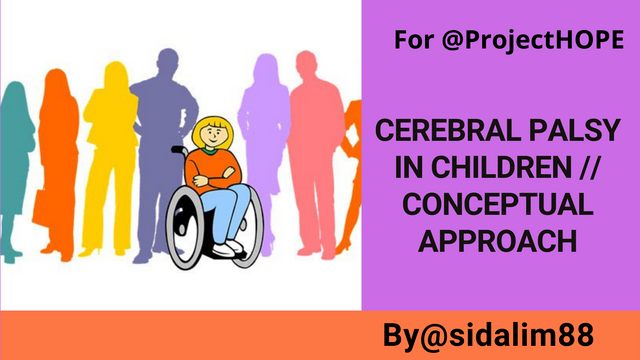.png)
Hello my dear readers who make up this platform of @ProjectHope, this time I want to share with you some information regarding cerebral palsy in children and what are the symptoms that identify this medical disorder..
INTRODUCTION
Cerebral palsy is a disease that affects public health worldwide, which is why several doctors have been precursors of their research, in order to find a justification of why this disease and how to classify it, however, the first doctor who made known this condition was William Little in 1860, who through his medical research described a disorder that consisted in the immobility of muscles and affected children during their first years of life. They had problems walking, crawling or holding an article. In the following topic we will define the concept of cerebral palsy and some causes and symptoms that provoke it.
INFANTILE CEREBRAL PALSY
It is represented by the acronym (CP) and consists of a disorder that basically affects muscle mobility and body posture of infants, this is due as a result of some injury in the proper development of the brain, clinically known as neuromotor damage, which can originate in the first days of gestation and 5 years of infant life. Other possible reasons for this terrible condition are some inconvenience during childbirth such as lack of oxygen in the brain or postnatal as a strong infection or blows to the skull.

SYMPTOMS AND CAUSES OF PC
The main symptoms that can be observed in an infant suffering from this disorder is the difficulty that they present before the first 3 years to turn, crawl, walk or even smile, however these symptoms may vary and be more noticeable depending on the degree of damage that the child presents at the brain level.
Currently it has not been possible to define a cause for the existence of infantile cerebral palsy, however, according to the investigations of experts in the field, it has been concluded that this disease can originate during pregnancy due to lack of oxygen in the brain, exposure of the mother during pregnancy to X-rays, rubella, strong prenatal infections, blood incompatibility, diabetes, intracranial hemorrhage, among others.

Likewise, during childbirth, babies are still at risk of adopting this disease if they present some of these cases such as: perinatal asphyxia, placental abruption, blows or trauma to the head or hemorrhage.

In this sense, up to the first 5 years of life, infants are not free from the possibility of suffering from this disorder if they have cardiovascular accidents, meningitis, anoxia, intoxication, dehydration or brain trauma during their childhood.
There are also cases in which it has not been possible to determine what has been the cause of the development of this condition, it can only be confirmed that they have it due to the variations observed in the development at the cerebral level, since so far it has not been possible to confirm that this disease is of hereditary origin.
FINAL CONSIDERATIONS
Finally, this disorder can affect any child who has been subjected to any of the causes mentioned above, but especially if they come to experience lack of oxygen in the brain, which is a common denominator in many of the risk situations that children from the time they begin to fertilize in the womb of the mother and up to approximately 5 years of age may suffer from these conditions. Subsequently we will be expanding more on this topic see you in a next delivery appreciated lectures.
MATERIAL CONSULTED
Madrigal Muñoz, Ana. Cerebral palsy. Source:
Kleinsteuber Sáa, Karin. (2014). Cerebral palsy. Source:
Espinoza Diaz, Cristóbal Ignacio. Prevalence, risk factors and clinical features of infantile cerebral palsy. Source:
Vázquez Vela, Cristina Calzada. (2014). Infantile cerebral palsy: definition and classification throughout history. Source:


Hi @sidalim88
Good content that you have developed for us, thank you for this educational delivery that you bring in this opportunity, I had heard of this disorder before no doubt, for science to determine its cause has not been anda simple.
Best regards, be well.
Downvoting a post can decrease pending rewards and make it less visible. Common reasons:
Submit
Greetings @lupafilotaxia.
I hope you had a happy new year with your loved ones. Thanks to you for reading my work, we will continue to work for them.
Downvoting a post can decrease pending rewards and make it less visible. Common reasons:
Submit
Hello friend, the truth is a very complicated disease and to see it in children is sad, but well unfortunately it must exist, fortunately there are doctors who work to get the best treatments and give the best of themselves to improve their quality of life. Greetings.
Downvoting a post can decrease pending rewards and make it less visible. Common reasons:
Submit
Hola amiga @franyeligonzalez.
I wish you a happy and blessed 2022. Yes, it is very unfortunate to see how children can go through such complicated disorders that often leave serious consequences.
Downvoting a post can decrease pending rewards and make it less visible. Common reasons:
Submit
Mother's has a long way to play in stoping this disease and also the midwife. Immediately a woman notice she is pregnant she should go to the hospital and register for antenatal immediately and be ready to open up all her disease conditions and anything she noticed immediately to the doctor or midwife for prompt action. The role of the midwife is to gather enough knowledge to prevent this disease from happen and also enlighten the ecpentant mother about this disease.
Downvoting a post can decrease pending rewards and make it less visible. Common reasons:
Submit
Hi @jennyvic09.
Happy New Year 2022. Undoubtedly a medical control is essential to determine any type of condition during pregnancy, unfortunately there are still mothers who do not give the necessary importance to this control.
Downvoting a post can decrease pending rewards and make it less visible. Common reasons:
Submit